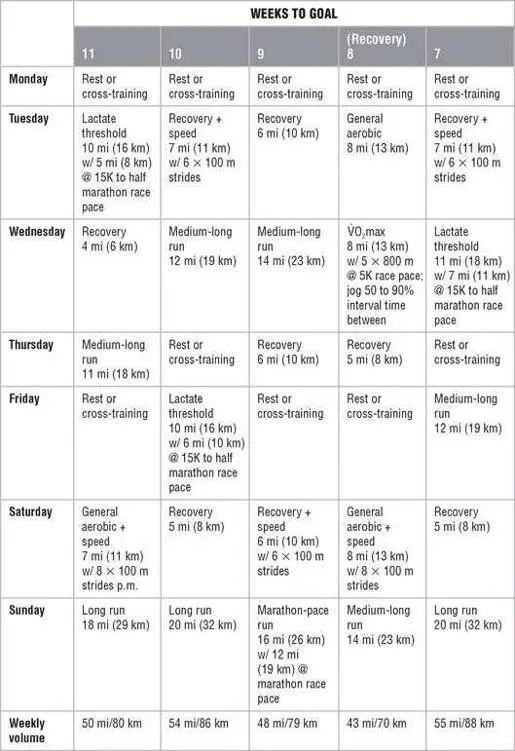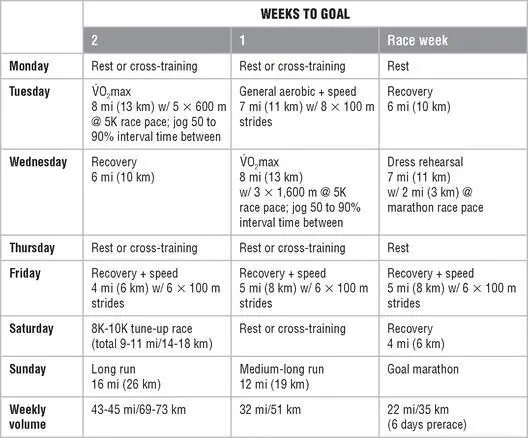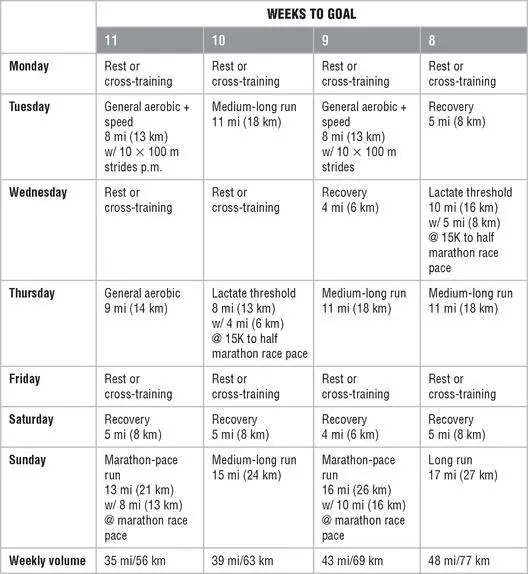Pfitzinger Pete - Advanced Marathoning
Здесь есть возможность читать онлайн «Pfitzinger Pete - Advanced Marathoning» весь текст электронной книги совершенно бесплатно (целиком полную версию без сокращений). В некоторых случаях можно слушать аудио, скачать через торрент в формате fb2 и присутствует краткое содержание. Год выпуска: 2008, Издательство: Human Kinetics - A, Жанр: Спорт, на английском языке. Описание произведения, (предисловие) а так же отзывы посетителей доступны на портале библиотеки ЛибКат.
- Название:Advanced Marathoning
- Автор:
- Издательство:Human Kinetics - A
- Жанр:
- Год:2008
- ISBN:нет данных
- Рейтинг книги:5 / 5. Голосов: 1
-
Избранное:Добавить в избранное
- Отзывы:
-
Ваша оценка:
- 100
- 1
- 2
- 3
- 4
- 5
Advanced Marathoning: краткое содержание, описание и аннотация
Предлагаем к чтению аннотацию, описание, краткое содержание или предисловие (зависит от того, что написал сам автор книги «Advanced Marathoning»). Если вы не нашли необходимую информацию о книге — напишите в комментариях, мы постараемся отыскать её.
Advanced Marathoning — читать онлайн бесплатно полную книгу (весь текст) целиком
Ниже представлен текст книги, разбитый по страницам. Система сохранения места последней прочитанной страницы, позволяет с удобством читать онлайн бесплатно книгу «Advanced Marathoning», без необходимости каждый раз заново искать на чём Вы остановились. Поставьте закладку, и сможете в любой момент перейти на страницу, на которой закончили чтение.
Интервал:
Закладка:
The schedules express each day’s training in miles and kilometers; use whichever you’re accustomed to. The mile and kilometer figures for each day (and the weekly total) are rough equivalents of each other, not a conversion from one to the other accurate to the third decimal point.
Following the Schedules
Each column of the schedules represents a week’s training. For example, in the 12-week schedule, the column for 11 weeks to goal indicates that at the end of that week you have 11 weeks until your marathon. The schedules continue week by week until race week.
We have included the specific workout for each day as well as the category of training for that day. For example, in the 18-week schedule, on the Friday of the 7-weeks-to-goal column, the specific workout is a 12-mile (19 km) run, and the category of training for that day is medium-long run. This aspect of the schedules allows you to quickly see the balance of training during each week and the progression of workouts from week to week. Look again at the 18-week schedule – it’s easy to see that with 7 weeks to go until the marathon, there are four recovery days (two of running, two of rest or cross-training), along with a lactate-threshold session, a long run, and a medium-long run. Looking at the row for Sunday, it’s easy to see how the long runs progress and then taper in the last few weeks before the marathon.
The workouts are divided into the following eight categories: long runs, medium-long runs, marathon-pace runs, general aerobic runs, lactate-threshold runs, recovery runs,  O 2max intervals, and speed training. Each of these categories is explained in depth in chapter 7, and the physiology behind the training is explained in chapter 1.
O 2max intervals, and speed training. Each of these categories is explained in depth in chapter 7, and the physiology behind the training is explained in chapter 1.
The 18-week schedule is recommended for most situations and is ideal for preparing for a marathon of great personal importance, like the New York City Marathon.

Racing Strategies
We discussed marathon race strategy at length in chapter 6. If you follow one of the schedules in this chapter, you’re probably a midpack runner. Unlike the situation the runners at the front of the field often face, you’ll probably have plenty of people around you to run with from start to finish. This can be good and bad.
On the plus side, obviously, you’re less likely to face lonely stretches with nobody to run with. Use this probability to your advantage – soon after the start, try to find other runners who look capable of maintaining your goal pace through at least 20 miles (32 km), and encourage them to work with you. (If they fall apart at 21 miles, that’s their problem, right?)
By following one of this chapter’s schedules, you’ll be better able to hold up past 20 miles (32 km) than most of the runners who begin the race at your pace. Your superior preparation will mean you’ll have the pleasure of continually passing people until the finish. Look forward to this time. Pick a runner a few hundred yards or meters up the road, and set the short-term goal of catching him or her. Then go after your next victim, and keep doing so until the finish.
On the not-so-good side, you’re more likely than those at the front of the field to feel crowded in the early miles. Try not to let this upset you. Tell yourself that the crowds are helping you not to go out too fast, and if need be, work up gradually to your goal pace.
Don’t try to make up lost time suddenly if a break in the crowd appears. Instead, when you have clear running room, run no more than 10 seconds per mile (per 1.6 km) faster than goal pace until you’re back on schedule; you will burn less glycogen and be less likely to accumulate lactate by catching up gradually. If the deficit you have to make up isn’t too great, 5 seconds per mile (per 1.6 km) faster than goal pace is an even safer approach. Once you’re back on track, ease back to goal pace.
After the Marathon
The final schedule in this chapter is a 5-week recovery schedule for after the marathon. This is the fifth mesocycle; it completes the training program and leaves you ready to prepare for future challenges.
The recovery schedule is purposely conservative. You have little to gain by rushing back into training, and your risk of injury is exceptionally high at this point, owing to the reduced resiliency of your muscles and connective tissue after the marathon.
The schedule starts with 2 days off from running, which is the bare minimum of time away from running you should allow yourself. If you still have acute soreness or tightness so severe that it will alter your form, or if you just don’t feel like running, certainly feel free to take more than 2 days off. If ever there was a time to lose your marathoner’s mind-set, the week after your goal race is it. Even most of the top runners in the world take days off after a marathon. They know that the nearly negligible benefits of a short run at this time are far outweighed by the risks. Not running now also increases your chances of being inspired to resume hard training when your body allows it.
Of course, some people don’t consider themselves real runners unless they run pretty much every day of their lives. Plod through a few miles if you must, but be aware that you’re prolonging your recovery.
What better aids recovery during this time is light cross-training, such as swimming or cycling. These activities increase blood flow through your muscles without subjecting them to pounding. Walking will also achieve this in the week after the marathon.
One way to ensure that you don’t run too hard too soon after your marathon is to use a heart rate monitor. As discussed in chapter 3, a heart rate monitor can help prevent you from going too fast on recovery days. During the first few weeks after the marathon, keep your heart rate below 76 percent of your maximal heart rate or 70 percent of your heart rate reserve. Running at this intensity will help your body overcome the stress of the marathon as quickly as possible.
During this 5-week recovery schedule, the number of days of running per week increases from 3 to 5. At the end of the 5 weeks, you should be fully recovered from the marathon and, with a little luck, be injury free and mentally fresh.
Mesocycle 1 – Endurance

Mesocycle 2 – Lactate Threshold + Endurance

Mesocycle 3 – Race Preparation

Mesocycle 4 – Taper and Race

Mesocycle 1 – Endurance

Mesocycle 2 – Lactate Threshold + Endurance

Интервал:
Закладка:
Похожие книги на «Advanced Marathoning»
Представляем Вашему вниманию похожие книги на «Advanced Marathoning» списком для выбора. Мы отобрали схожую по названию и смыслу литературу в надежде предоставить читателям больше вариантов отыскать новые, интересные, ещё непрочитанные произведения.
Обсуждение, отзывы о книге «Advanced Marathoning» и просто собственные мнения читателей. Оставьте ваши комментарии, напишите, что Вы думаете о произведении, его смысле или главных героях. Укажите что конкретно понравилось, а что нет, и почему Вы так считаете.










